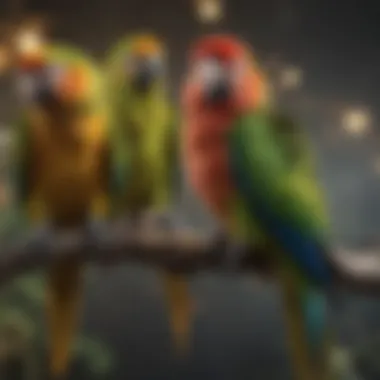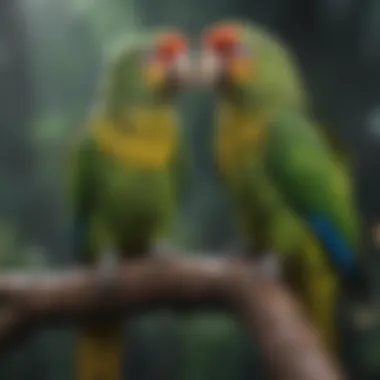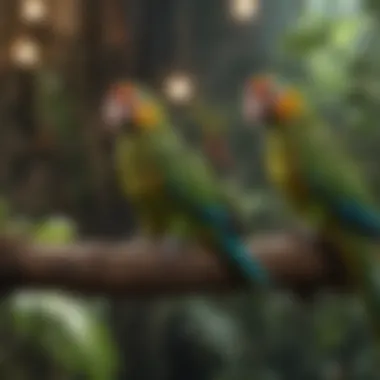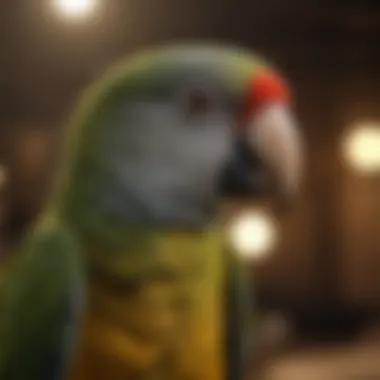Understanding Amazon Parrot Prices: A Comprehensive Guide


Intro
Understanding the pricing of Amazon parrots requires a careful examination of various factors that contribute to their value. These birds, known for their vibrant colors and expressive nature, command a broad price range influenced by species differences, age, and where they are sourced. Whether one is looking to add a feathered friend to their family, raise them as a hobby, or enter into breeding, grasping these aspects is crucial.
The relationship between parrots and their owners is significant in determining how much they will spend. Initial costs may vary greatly, but ongoing expenses, care, and commitment must also be part of a new owner’s budget considerations. Consequently, understanding the economics behind Amazon parrot prices becomes not just about acquisition but about holistic ownership.
This guide aims to delineate essential insights, comprehensively covering the elements both prospective owners and enthusiasts must know when pondering the introduction of an Amazon parrot into their lives. By breaking down costs, responsibilities, and different circumstances, readers will feel more prepared to embark on this journey.
Avian Care Basics
Most people often overlook that the purchase price is only the beginning. Owning an Amazon parrot requires recognition of essential care aspects that will influence lifetime happiness and well-being for the bird. This section explores fundamental care practices vital to a parrot's health and ensures a strong start to the ownership experience.
Importance of Proper Nutrition
A well-balanced diet is critical in maintaining the physical and emotional health of an Amazon parrot. It is essential to provide a mix of seeds, pellets, fruits, and vegetables. High-quality pelleted food usually forms the basis of their diet, though they should also receive fresh produce, such as leafy greens and other vitamins.
Maintaining nutrition fosters a robust immune system while aiding in long-term lifespan of the parrot.
Understanding Bird Species and Their Needs
Each Amazon parrot species has distinct traits and behaviors. For example, the Double Yellow-headed Amazon and the Yellow-naped Amazon are known for their vocal abilities and sociable nature. It’s imperative for potential owners to research the specific requirements they should meet, both understood on educational platforms such as Wikipedia and firsthand experience shared in communities like Reddit.
Basics of Birds Habitat Setup
Creating a suitable habitat for Amazon parrots encompasses choosing an appropriate cage, making space for play, and providing enrichment activities. The right cage should be spacious enough to move comfortably, with horizontal bars to support climbing, along with perches of varying materials to promote foot health.
Adding toys and materials which encourage mental stimulation is another crucial element to consider during setup.
Grooming and Hygiene Tips
Hygiene is paramount, involving routine cleaning of the bird’s living space and maintaining feathers. Regular nail trimming and beak care must also be included in grooming routines.
Utilizing safe natural materials during play and interaction models a clean environment where a parrot can thrive. Regular check-ups from a qualified vet can complement general behavioral health.
Insight: Regular grooming activities also ground the bird’s loyalty and trust with its owner, and this strengthens the bond significantly.
Interacting with Your Pet Bird
Interacting positively impacts both the emotional and physical aspects of an Amazon parrot’s life. Understanding how to carefully bridge between training and daily communication ensures a satisfying experience for bird and owner alike.
Building Trust and Connection
Creating a trustful relationship starts with gentle introduction and consistent interaction. A parrot’s initial reaction may be wary, thus building trust takes both patience and time, complicating quick notions of training methods.
Training Techniques and Tips
Intelligent and social, Amazon parrots often excel in training. Simple commands like ‘step-up’ or whistle cues can facilitate smoother interaction and promote mutual respect. By utilizing positive reinforcement such as treats, a parrot learns effectively.
Fun Activities for Bird Owners and Their Birds
Engaging parrots in activities creates lasting bonds. Interchangeable toys should serve to strain mental faculties, while providing opportunities for play can result in joyful experiences both by owner and pet.
Recognizing Bird Cues and Behaviors
Awareness of an Amazon parrot’s language is essential for successful communication. Certain vocalizations coupled with body movements can denote happiness, stress or concern. Observing and understanding cues is critical in ensuring a fulfilling connection.
Emotional Well-Being of Birds
Amazon parrots are known for their emotional depth. Addressing the subtle nuances contributing to their mental state is vital for successful ownership. The dynamics of nurturing incorporated in daily interactions will facilitate flourishing emotional health.
The Role of Play and Socialization


Challenges are often minimized through reinforced impressiveness and scheduled patterns for social engagement. Play structures are additionally instrumental in expressing natural instincts while socializing promotes emotional growth.
Enhancing Birds' Emotional Health
Interactive play, ample freedom, and beneficial social habits dramatically impact well-being. A supportive (and safe) atmosphere pepares playful enrichment that eases both owners and birds.
Assessing Bird Stress and Remedies
Recognizing signs of stress helps initiate valuable discussions early, allowing you to adjust your environment or routines in a caring direction.
Building Strong Human-Bird Bonds
Consistent commitment guarantees progress. Regular nurturing directs emotional companionship and mutual joys provide conditions for lasting joy. Positive experiences foster trust building, enhancing long-term happiness.
Bird Health and Safety
Valuing the health and welfare of Amazon parrots will directly affect their overall well-being. Addressing disciplines of safety and illness shows remaining informed ensures optimal decisions will flourish through chow experience.
Common Health Issues and Prevention
Identifying frequent health issues prepares a holder for standard avian practices. Issues like feather plucking, dietary problems, and infections need readiness and diligence for identifiers.
Routine Veterinary Care
Committing to regular veterinary check-ups monitors minor problems ensuring they do not develop into greater burdens down the road. End-on examinations can enable noticing concerning changes prior to larger challenges.
Environmental Hazards to Avoid
Avoid common hazards include toxic plants like oleander or exposure to household hazards could create controllable lengthy distress situations.
Signs of Illness or Distress
Identifying signs alerts issues emerge swiftly. Lethargy, respiratory changes, and changes in feeding patterns warrant further attention from qualified vet preferably.
Fun Facts and Quirky Insights
Adding light to broader ownership experiences strives to uncover quirky facts and signs shared by Amazon parrots. This culminates wider forums into more enlightening sessions centralized by joyful moments spent.
Unique Traits of Popular Bird Species
Many species present distinct characteristics. The various ability to perform and enunciate human-like phrases highlights their unique understanding. Melodic linguistics keeps dialogues exciting and improves bonding.
Historical and Cultural Significance of Birds
Amazon parrots hold valuable historical roots linking tribes across Bolivia and Brazil, where they feature symbolically. Cultural impact strives a mission for guidance path wanting enrichment of thought.
Famous Bird Owners and Their Stories
Accounts associated with figures celebrates human-bird shares to their awe inspiring fits will allow word-spreading existence. Accounts circle potential implementing to uplift exploration.
Ensuring awareness about fluctuation costs in an ownership approach reinforces the economic link. The interplay shared scrolls eligibility during procurement invitations built prolific joint affectionate fits around experiences.
Prelims to Amazon Parrots
Understanding the Amazon parrot is crucial for anyone considering ownership of this vibrant and intelligent species. When we briefly explore their attributes, needs, and behaviors, we lay the foundation for insightful discussions about their pricing influences and care requirements. Notably, Amazon parrots are known for their social nature and ability to mimic speech, which makes them cherished companions for many.
Potential parrot owners must consider various elements before making decisions. These include suitability regarding the pet choice, lifestyle compatibility, and long-term commitment the owners must embrace. This article aims to furnish readers with an overview that embraces these considerations thoroughly.
Overview of Amazon Parrots
Amazon parrots comprise several species, each characterized by unique traits and behaviors, affecting their desirability and placement in the avian marketplace. A defining feature of Amazon parrots is their intelligence, enabling them to form strong emotional bonds with their caregivers, which enhances their appeal as household pets.
In the wild, these parrots are found in diverse habitats ranging from rainforests to savannas, primarily in Central and South America. Their splendid plumage and engaging disposition contribute largely to their popularity, but this intrinsic charm is intertwined with an intricate pricing structure influenced by various factors.


It is crucial to recognize that ownership goes beyond initial costs. Long-term care demands specific knowledge and understanding, as factors that affect initial price also play significant roles in ongoing ownership costs.
As we explore more about Amazon parrots in this article, it is essential to weigh both the joys of companionship they offer along with their requirements and financial implications.
Factors Influencing Amazon Parrot Prices
Understanding the factors that influence Amazon parrot prices is essential for anyone considering making one of these birds a pet. Prices do not only reflect the monetary value of the parrots but also their uniqueness, which can provide insight into what potential owners might expect in terms of care, commitment, and overall investment.
There are various aspects that affect prices. Ranging from species variations to market demands, knowing these variables can disrupt or align expectations for prospective parrot owners. By first evaluating why such differences occur, one can make better-informed decisions. Below are some delineated specifics.
Species Variations and Pricing
Each Amazon parrot species comes with its own pricing structure depending on rarity and demand. There are several species in this group, each exhibiting different colors, sizes, and intelligence levels. For instance:
- Yellow-Naped Amazon: Often pricy due to its stunning color and good talking ability.
- Double Yellow-Headed Amazon: Highly sought after, can command higher prices due to its popularity.
When considering each species, on can see clear disparities based on features like size and vocal ability. These factors not only intrigue buyers but also elevate price tags.
Age of the Parrot
Age is another critical element influencing cost. Young parrots, especially those still in their fledgling stage, can be more expensive. This reflects their potential lifespan and training opportunity. Many buyers prefer younger birds, viewing them as easier to handle and train.
Older parrots might be priced lower. While they might come with developed personalities, procurement of these birds involves careful inspection of their health and behavior feasibility for lifelong companionship. Assessing age along with genre seasonality can seem revelatory in the shopping processes.
Breeding Conditions
The manner in which a parrot has been bred and raised largely influences its selling price. Ethical breeders typically prioritize health, temperament, and correct weaning processes. Birds that arise from such comfortable settings tend to have a higher rate, resulting in better overall wellness assurance.
Backyard breeding or those engaging in fld or inconsistent feeding might offer lower prices, but it's essential to remember that quality tends to come higher with responsible breeding practices. Understanding being around reputable breeders matter.
Market Demand and Supply
Market demand and supply dynamics play a sizable role in determining prices. When demand increases faster than supply—including new pet owners wanting companionship and bird enthusiasts—prices skyrocket. Conversely, when the bird population rises and someone gets a prominent feature on social media, costs might decline.
Limited editions or acclaimed shows can further augment prices. साथ इतने अलग-अलग फैक्टर्स के कारण उदाहरणांसवरथ बाचप्पा में खूबो बताती हैं, प्रजेर आपके gewünschtes में कैसा होगा इस अनूठे समझ का रवि देती है। Keeping attuned to these variations is vital for thoughtful purchasing behavior.
This comprehensive knowledge provides insights necessary for prospective Amazon parrot owners. With awareness of these given factors in mind, ownership enthusiasts can begin understanding possible future costs and financial commitment.
Typical Price Ranges for Amazon Parrots
Understanding typical price ranges for Amazon parrots gives potential owners or breeders key insights into what they can expect when making a purchase. Knowing the price nuances can shape performance expectations and significantly impact budgeting. Parrots are remarkable pets, but they can also be costly. Therefore, understanding the financial aspect of acquiring a bird is imperative for informed decision-making in bird ownership.
Common Species Price Overview
When looking at the common species of Amazon parrots, it's helpful to highlight a few. These include the Yellow-Naped Amazon and the Double Yellow-Headed Amazon.
- Yellow-Naped Amazon usually ranges from $1,500 to $2,500.
- Double Yellow-Headed Amazon can be between $1,000 to $1,800.
These prices often reflect the bird's age, quality of captivity, and reputation. Birds from reputable breeders might offer slightly higher initial expenses. However, quality can often translate to health effectiveness. Potential owners should compare these price points within their budgets.
As a point of consideration, local demand can influence prices. Areas with higher availability of breeders may result in more competitive pricing. Similarly, high demand can spike up the rates due to scarcity.
Rare Species Pricing
A rare species can command substantially higher prices. For example, the Blue-Faced Amazon or the Red-Lored Amazon might feature prices soaring up to $3,000 or more. Prices can vary constently depending on factors such as:
- Breeding source: Rare species often come from specialized breeders with papers proving their lineage and wellbeing.
- Health and temperament: Healthier and better-socialized birds may dramatically change depending on various sources providing them.
- Market scarcity: Availability drastically impacts the pricing of rare parrots, with keen collectors or investors driving prices even higher.
Overall, understanding the significant distinction between common and rare species prices aids prospective buyers in understanding the economic landscape of Amazon parrots.
Considerations Beyond Purchase Price


When evaluating the costs of owning an Amazon parrot, it is crucial to look beyond the initial purchase price. Many prospective owners focus solely on the expenditure required to acquire a bird without fully understanding the subsequent commitments involved in its care. Each Amazon parrot has its own needs depending on its specific species, age, and health status, which can lead to substantial expenses over time. This section will enlighten potential owners on the tangible and intangible aspects of parrot ownership, moving beyond just the upfront cost of buying a bird.
Initial Setup Costs
Initial setup costs encompass all expenses involved in creating a suitable living environment for your Amazon parrot. While it might be tempting to focus only on purchasing the bird, adequate preparation will lead to better quality of life for both the owner and the pet._
Key components of initial costs include:
- Cage: A large and robust cage is essential. Quality enclosures generally range from $150 to $500, depending on size and features.
- Bedding and Accessories: Food and water dishes, toys, and perches can be anywhere from $50 to $200. Choose items that will stimulate the bird and keep it healthy.
- Food supplies: Initial bulk purchasing of staple foods as well as treats may cost around $50 to $100.
- Health check: A trip to the vet, which may cost $50 to $200 for an initial examination, is important to assess the health status before bringing your bird home.
These initial expenses can add up significantly, so planning for them ahead of time offers a smoother transition into bird ownership.
Ongoing Care Expenses
Owning an Amazon parrot entails consistent daily costs which many individuals often overlook. Care for a parrot includes nutrition, environment upkeep, and regular medical attention. Financially, the ongoing expenses can accumulate quickly, often adding up to hundreds of dollars annually.
Important ongoing care expenses include:
- Food: A diet consisting of pellets, fruits, and vegetables can cost between $25 and $50 monthly.
- Toys: Regular replacement of toys (to avoid boredom) can entail $100 to $200 each year, depending on usage.
- Veterinary Care: Routine checkups and vaccinations can cost $100 to $250 annually, not including unexpected medical issues, which often arise unexpectedly.
- Cage maintenance: Regular cleaning and replacement of bedding every one or two weeks may incur a cost of around $20 per month.
These daily and weekly routines ensure the health and happiness of your Amazon parrot, leading to a fulfilling companionship.
Unexpected Costs of Ownership
No bird owner expects to incur hidden costs; however, surprises can often occur in any pet ownership scenario. This unpredictability can challenge even the most prepared buyers. Upscale vet visits can happen suddenly when birds show health signs that need immediate attention.
Considerations for unexpected costs include:
- Health Emergencies: Illnesses or injuries may demand unexpectedly high vet fees that could reach several thousand dollars.
- Travel Arrangements: If you travel often or need to relocate temporarily, boarding facilities for birds can run between $15 to $100 per day.
- Behavioral training: Some Amazon parrots need behavioral therapy due to stress or aggression, a specialist may charge $50+ per session.
Considering these elements provides a more understanding framework for anyone evaluating the feasibility of bringing an Amazon parrot into their lives. Proper knowledge allows for an informed decision based on full scope of commitment.
Where to Purchase Amazon Parrots
Knowing where to purchase Amazon parrots is essential for prospective owners. Making an informed choice can significantly impact the overall quality of your bird's life and your ownership experience. The source from which you acquire your parrot not only influences the purchase price but also factors in the overall health, temperament, and background of the bird. There are specific elements, benefits, and considerations to take into account when deciding where to buy an Amazon parrot.
Reputable Breeders
Purchasing an Amazon parrot from a reputable breeder is one of the foremost recommendations. Good breeders usually prioritize the health and welfare of their birds. They tend to conduct frequent veterinary checks, ensure adequate socialization, and provide a stable environment for the parrots until they find a new home. Breeders can also offer valuable insights about how to care for the parrot. They may provide historical data concerning the bird's lineage. Often, they engage in responsible breeding practices to avoid inbreeding, which can lead to health problems. Additionally, a reputable breeder may have the skills to answer in-depth questions you might have between various species. This extra knowledge benefits the bird as well as the owner.
Pet Stores
Buying from a pet store is another option, but this requires caution. While several chain and independent pet stores may offer healthy Amazon parrots, not all of them meet high animal welfare standards. Resultantly, it's crucial to observe the birds' living conditions, dietary needs, and general well-being. Some stores may acquire birds from less ethical breeders, meaning they prioritize profit over the animal's health. Integrity of practices should be assessed closely. When considering either small shops or large retail establishments, there is often a variation in customer service. Some stores may provide additional resources such as food, toys, or consultation that can benefit new buyers, especially those who are first-time pet parrot owners.
Rescue Organizations
Rescue organizations are valid and humane options to consider when wanting an Amazon parrot. Many parrots end up in shelters for various reasons, including changes in their owner’s lifestyle or an inadequate living situation. Adopting an Amazon parrot from a rescue can both save a life and offer a fulfilling experience. These organizations typically assess the health and behavior of their birds and can provide guidance on the unique needs of each parrot. Besides, adopting often comes with a significantly lower initial cost. Note that rigorous application processes may be in place to ensure that the birds go to responsible and suitable homes.
Adopting a bird can be a fulfilling experience, as it provides a home for parrots that might otherwise face prolonged periods in shelters.
Each purchasing avenue comes with distinct benefits and potential concerns. Researching your options beforehand is vital. Your choice influences not just cost but the quality of support you might receive as a new parrot owner.
End
In the discussion of Amazon parrots, understanding pricing is critical. Knowledge of the factors affecting these prices enables potential owners to make smart decisions. The information provided reflects the complexity of parrot ownership.
From species variations to age, every detail contributes to price noticeably. Recognizing this can lead to meaningful insights, which benefit both the buyer and the bird.
Beyond mere purchase often lies additional costs that should not be overlooked. Factoring in the ongoing routine care and potential unexpected expenses is essential. This comprehensive guide offers clarity about initial purchase costs, enhancement of market knowledge, and pet care obligations.
Ultimately, an informed choice can lead not only to satisfaction but also a healthier life for your Amazon parrot. Owning a parrot impacts not just your life but also the bird’s well-being, making the comprehension of these key elements invaluable.
Summarizing Key Insights
As we conclude this exploration into the world of Amazon parrot prices, several insights stand out:
- Species Differences: Different Amazon parrot species exhibit distinct pricing structures. Rare species generally command a higher price.
- Parrot Age: Younger parrots usually fetch higher prices. Their potential and leg of ownership play a significant role here.
- Breeding: Professional breeders can have differing prices based on their practices, which often assure potential buyers of quality and health.
- Market Dynamics: Prices fluctuate based on demand and supply. Being aware of market trends helps in making a sound financial decision.
- Beyond Purchase: Costs exceed the initial price tag. Costs of habitat setup, food, and veterinary care accumulate over time with ongoing responsibilities.
Understanding these components fosters better planning and housing conditions for Amazon parrots. This knowledge significantly enriches the hopeful owner's journey, ensuring both informed choices and lasting companionship.















